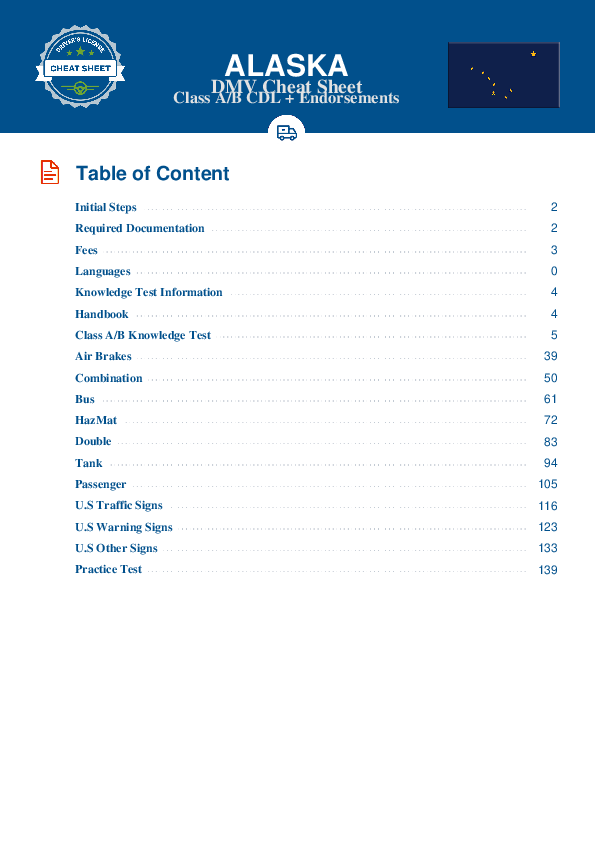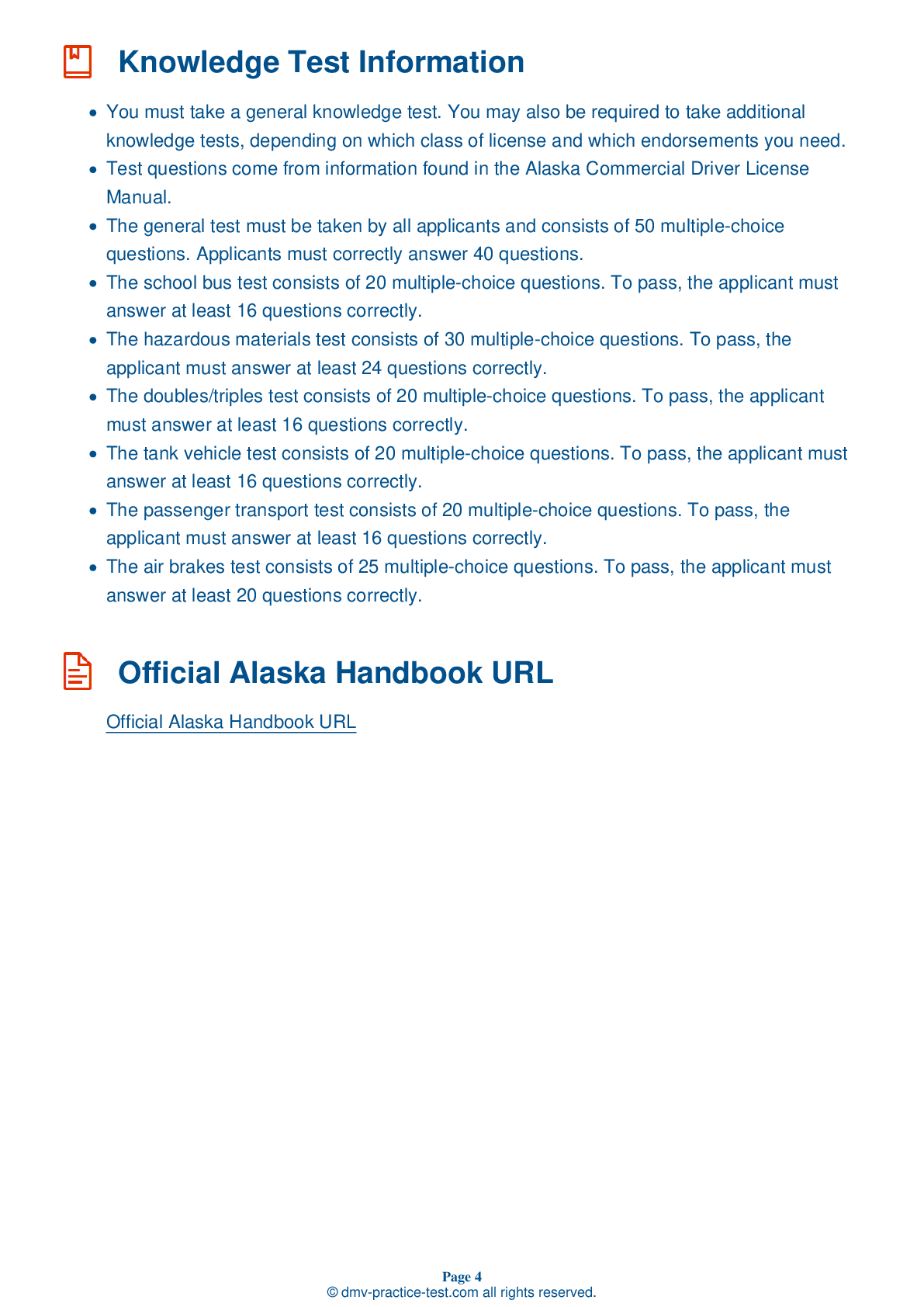Passenger #2
Passenger Endorsement | Alaska 2025 #2 Page 3 of 3
Train for FREE with our Alaska CDL passenger endorsement practice test online. The official exam test consists of several obligatory parts, with all of them checking your knowledge of different blocks of road rules. If you need to obtain a AK DMV passenger endorsement in 2025, practice as much as possible. Free sample tests published on our website will help you check and improve your knowledge and boost your grades. Please bear in mind that DMV requirements for issuing a CDL permit with passenger endorsement may vary from state to state.
20
16
20
15 . When driving at highway speeds, you should watch the road about ____ ahead of your vehicle.
Stay aware of upcoming obstacles and hazards by consistently watching the road at least 12 to 15 seconds ahead of your vehicle. When traveling at highway speeds, this is equivalent to about a quarter of a mile.
16 . How does doubling your speed from 20 mph to 40 mph affect your vehicle's braking distance?
Increasing your vehicle's speed will increase your vehicle's striking power and braking distance. Doubling your vehicle's speed from 20 to 40 mph will quadruple its braking distance.
17 . If you must back up, it is helpful to:
If you must back up, you should exit the cab and check your path for obstacles before beginning the maneuver. Drive as slowly as you can, checking your mirrors on both sides.
18 . Which of the following is not a type of distraction?
Distractions that can affect safe driving can be classified as physical (such as reaching for an object), mental (such as talking with passenger), or both (such as talking on a hand-held phone).
19 . When parked on the side of the road:
Always turn on your four-way emergency flashers if you must park on the side of the road. This is especially important when traveling at night.
20 . When driving a vehicle, rough acceleration is:
When accelerating, speed up smoothly and gradually so your vehicle does not jerk. Rough acceleration can cause mechanical damage.
2025 Alaska | Frequently Asked Questions
A CDL Class A license in Alaska is defined as a commercial driver's license that allows holders to operate any combination of vehicles with a Gross Vehicle Weight Rating (GVWR) of 26,001 pounds or more, provided the towed vehicle is heavier than 10,000 pounds. It typically covers vehicles like tractor-trailers, truck and trailer combinations, tank vehicles, and livestock carriers.
A Class A CDL license in Alaska allows the holder to operate vehicles such as tractor-trailers, truck and trailer combinations, flatbeds, livestock carriers, and tank vehicles. The license covers any combination of vehicles with a Gross Vehicle Weight Rating (GVWR) of 26,001 pounds or more, given the towed vehicle exceeds 10,000 pounds.
To obtain a Class A CDL license in Alaska, you must be at least 18 years old (21 for interstate driving), possess a valid driver's license, pass a vision test, and complete a written knowledge test. You're also required to pass a skills test, which includes a pre-trip vehicle inspection, a basic vehicle control test, and an on-road driving exam.
In Alaska, you must be at least 18 years old to obtain a Class A CDL for intrastate driving (within state lines). However, federal regulations require drivers to be at least 21 years old to drive commercial vehicles across state lines (interstate) or to transport hazardous materials.
While specific endorsements aren't required for a Class A CDL, they allow you to operate specialized vehicles. Endorsements include H (Hazardous Materials), N (Tank Vehicles), P (Passenger Vehicles), S (School Buses), T (Double/Triple Trailers), and X (Combination of Tank Vehicle and Hazardous Materials). Each requires an additional knowledge test, and some require a skills test.
The Class A CDL skills test in Alaska consists of three parts: a pre-trip vehicle inspection to assess your ability to determine if your vehicle is safe to drive, a basic vehicle control test to evaluate your ability to control the vehicle, and an on-road driving exam where you demonstrate your ability to safely drive the vehicle on public roads.
Yes, there are limitations for Class A CDL license holders. These include restrictions based on the driver's experience, age, health status, and specific vehicle features. For instance, drivers may have restrictions if they fail the air brake portion of the test or if they drive a vehicle without a full air brake system. Also, drivers under 21 are restricted to intrastate driving.
In Alaska, the written Class A CDL test is primarily administered in English to ensure drivers can understand road signs and signals. However, the state allows the use of translators or interpreters for those who don't speak English fluently. It's advisable to contact your local DMV office beforehand to confirm their specific policies regarding language assistance.
Yes, accommodations can be made for the Class A CDL written test in Alaska if you have a disability. You need to inform the DMV about your specific needs when scheduling your test. They can provide aids such as audio versions of the test, extra time, or quiet testing environments depending on your requirements.
Yes, if you don't pass the Class A CDL written test in Alaska, you can retake it. However, you must wait at least one day before retaking the test. The Alaska DMV allows multiple attempts, but repeated failures may require additional training or instruction before another attempt is allowed. Fees may apply for each test attempt.



